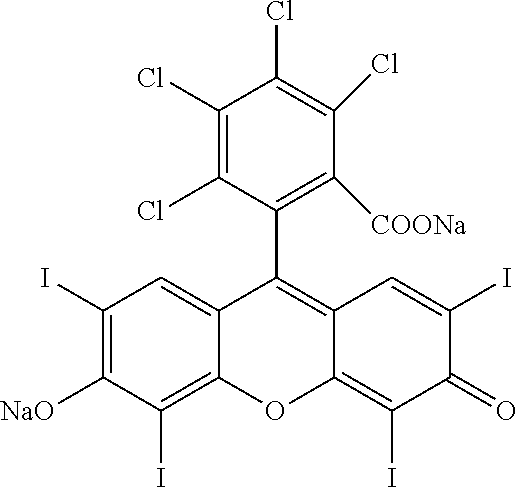Halogenated xanthene composition and method for treating hematologic cancers
a technology of hematologic cancer and composition, which is applied in the direction of drug compositions, peptides, immunoglobulins, etc., can solve the problems of increased increased the subsequent finding of breast cancer in previously treated women, and even less successful drug therapies of the blast crisis stage of cml
- Summary
- Abstract
- Description
- Claims
- Application Information
AI Technical Summary
Benefits of technology
Problems solved by technology
Method used
Image
Examples
Embodiment Construction
[0032]In one aspect, the present invention contemplates a pharmaceutical composition for use in the treatment (killing) of hematologic, non-tumorous cancer cells, e.g., leukemia, lymphoma and myeloma. A contemplated pharmaceutical composition comprises a 0.1% to about 20% (w / v) aqueous medium (as a liquid) of a first cancer cytotoxic agent that is a halogenated xanthene, a physiologically acceptable salt of the halogenated xanthene, or a C1-C4 alkyl ester thereof. A particularly preferred halogenated xanthene salt is rose bengal (4,5,6,7-tetrachloro-2′,4′,5′,7′-tetraiodofluorescein) disodium salt, as is present in PV-10. The composition is administered to provide a therapeutically effective amount of a first cancer cytotoxic agent to a mammal such as a human having a hematologic, non-tumorous cancerous disease such as leukemia, lymphoma and myeloma, or more specifically, acute lymphoblastic leukemia (ALL), acute myeloid leukemia (AML), non-Hodgkin's lymphoma (NHL), or Hodgkin's lymp...
PUM
| Property | Measurement | Unit |
|---|---|---|
| Time | aaaaa | aaaaa |
| Mass | aaaaa | aaaaa |
| Time | aaaaa | aaaaa |
Abstract
Description
Claims
Application Information
 Login to View More
Login to View More - R&D
- Intellectual Property
- Life Sciences
- Materials
- Tech Scout
- Unparalleled Data Quality
- Higher Quality Content
- 60% Fewer Hallucinations
Browse by: Latest US Patents, China's latest patents, Technical Efficacy Thesaurus, Application Domain, Technology Topic, Popular Technical Reports.
© 2025 PatSnap. All rights reserved.Legal|Privacy policy|Modern Slavery Act Transparency Statement|Sitemap|About US| Contact US: help@patsnap.com

